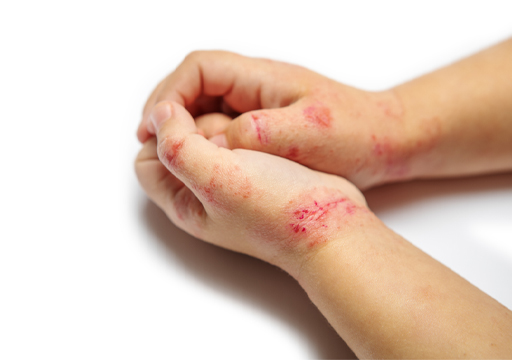4 The impact of physical health on mental health
In the previous section, you explored some of the common conditions that can affect young children’s mental health. However, children’s mental health can also be impacted by their physical health. For example, children are increasingly being diagnosed with chronic (meaning that they are ongoing) health conditions (World Health Organisation, 2020). The most common chronic conditions that affect young children in high income countries include asthma, diabetes and eczema. As many as 10–15% of children have asthma (NHS England, n.d.), which means that between 3 and 5 children in a class of 30 are likely to have asthma. Eczema is thought to affect 11% of young children and the number of children with Type 1 and Type 2 diabetes is also increasing.
Chronic conditions can have a profound impact on children’s lives; for instance, they may have dietary restrictions, or they may need to use inhalers or other medications, such as injections, to manage the symptoms. The symptoms of chronic conditions can set a child ‘apart’ from their peers, be painful and unpleasant, and, in some cases, life-threatening. For example, asthma attacks are still a cause of child deaths in the UK. It is not surprising that the presence of a chronic condition can be a source of great anxiety to a child (and their family) with one or more chronic conditions. It is not unusual for children to have a combination of chronic conditions; asthma, eczema and allergies are all conditions that frequently affect children. Physical conditions can have profound psychological consequences and sometimes there can be a range of interrelated symptoms that can create a complex picture in terms of a child’s overall health and wellbeing.
Activity 1 The possible impact of chronic health conditions
Read the following case study about Charlotte: her experience is based on a child taught by the author of this course. As you read it, consider the following questions:
- What are the possible effects of Charlotte’s chronic physical health conditions on her mental health and wellbeing?
- How could adults support Charlotte to improve her physical health and wellbeing?
Case study: Charlotte
Charlotte is 6 and she has had eczema since she was 5 months old. The eczema has been widespread and she has large patches of ‘angry-looking’ skin, which is red, inflamed and weeps fluid. The itchiness causes her to scratch relentlessly, to the extent that she causes herself to bleed. Despite her mother’s diligent application of creams and avoidance of many of the known triggers that provoke Charlotte’s eczema, it continues to be troublesome and it is having a profound impact on many aspects of her life as well as her family’s life. For instance, night times have always been difficult: Charlotte’s sleep has been affected by eczema because she has an almost continuous need to scratch.
As well as having eczema, Charlotte has recently been diagnosed with asthma. Before the diagnosis, she was coughing at night, which meant she was waking frequently; this also impacted on her sleep pattern. Asthma symptoms also affect Charlotte during the day; because she is short of breath, she finds it uncomfortable to run around outside and play with her friends, so she finds it easier to walk around with the teacher during playtime instead.
Furthermore, Charlotte is going through a period where her eczema is particularly troublesome. Her hands are especially affected with dry crusts that are prone to bleeding. Some of the children have noticed the blood and are starting to make comments that are very hurtful to Charlotte. Because of the children’s comments, Charlotte has started to be excluded from playtime activities. She has also realised that she is not being invited to birthday parties.
In addition to the social exclusion, Charlotte’s lack of sleep means she is always tired during the day. This means she is irritable with her friends, as well as finding it difficult to concentrate, so she is also struggling to keep up with her schoolwork. Her asthma is especially bad during the early summer when hayfever is at its worst; taking part in Physical Education (PE) and school events such as sports day is difficult for Charlotte. Consequently, she is not able to have many opportunities to exercise and to benefit from taking part in physical activity, which is important for a child’s wellbeing.
Discussion
Charlotte’s story is not unusual: asthma and eczema are conditions that often go together (i.e. are comorbid). The symptoms, such as the itchiness that eczema causes, can be very troublesome. Also, because her skin is so affected, the condition is very visible. Such visibility can cause distress to the child and, sadly, it can be a cause of social exclusion, as in Charlotte’s case.
In the same way that adults have a responsibility to teach children about tolerance and understanding in relation to race, colour, disability and class, there is also a responsibility to do the same in relation to other children's chronic health conditions.
In Charlotte’s case, it may be helpful for her teacher to work with her mother and the school nurse (if one is available) to identify ways of improving her participation in school life. The school nurse is likely to be able to offer support to Charlotte and her mum in improving Charlotte’s physical health; for example, by ensuring that she has access to creams and other medication while she is at school, which in turn would improve her wellbeing and mental health.

